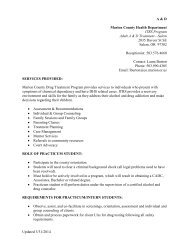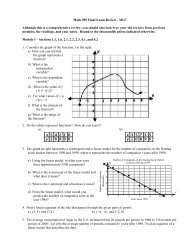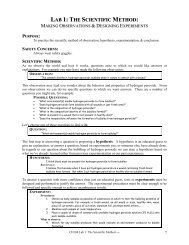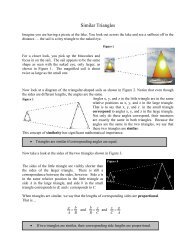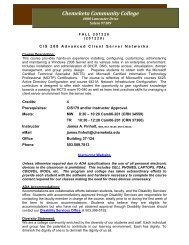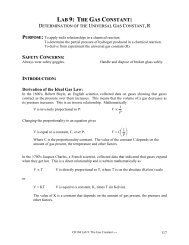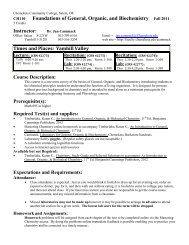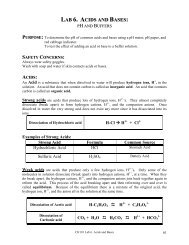Chem 102b Experiment 14: Part II Revised Preparation of Esters
Chem 102b Experiment 14: Part II Revised Preparation of Esters
Chem 102b Experiment 14: Part II Revised Preparation of Esters
Create successful ePaper yourself
Turn your PDF publications into a flip-book with our unique Google optimized e-Paper software.
Fischer esterification yields equilibrium between the reactants and products. As Le Chateliers<br />
principle states, the equilibrium system will adjust to minimize any stress applied to the system.<br />
If the concentration <strong>of</strong> either <strong>of</strong> the reactants is increased or if the concentration <strong>of</strong> either <strong>of</strong> the<br />
products (i.e. carboxylic acid and ester) is decreased, the reaction will "shift to the right." Thus,<br />
the yield <strong>of</strong> the products will be increased. Anhydrous sodium sulfate is a drying agent that<br />
absorbs water. If anhydrous sodium sulfate were added to the product collection flask, water<br />
would be removed and the reaction would be shifted to the right. The yield <strong>of</strong> the ester would<br />
increase.<br />
The experiment is to be performed by a group <strong>of</strong> 4 students. Each member <strong>of</strong> the group will<br />
make, isolate, and characterize one <strong>of</strong> the esters listed below using the Fischer esterification<br />
techniques. The product will be a liquid that will be purified via a two-step process. Purity <strong>of</strong> the<br />
product will be determined using Fourier Transform Infrared absorption Spectroscopy.<br />
Ester Alcohol Acid Boiling Point<br />
Ethyl Acetate Ethanol Acetic Acid 77 C<br />
Benzyl Acetate Benzyl Alcohol Acetic Acid 213 C<br />
Isopentyl Acetate Isopentanol Acetic Acid <strong>14</strong>2 C<br />
Octyl Acetate Octanol Acetic Acid 199 C<br />
IR spectra will be collected for each <strong>of</strong> the esters synthesized and compared within each group.<br />
IR spectra are specific for every compound and can be considered to be a kind <strong>of</strong> "fingerprint"<br />
for that compound. As you learned in the qualitative analysis experiment, compounds that share<br />
the same functional groups share some <strong>of</strong> the same properties. After the esters have been<br />
synthesized and characterized, the groups should compare boiling points and IRs <strong>of</strong> the products.<br />
You will be given spectra <strong>of</strong> the reactants. Please compare your analysis to the IRs <strong>of</strong> the<br />
reactants and make some assessments about the completion <strong>of</strong> your reaction. Please note that<br />
only the alcohol used to make the ester has changed. Consequently, the spectra for all the esters<br />
will have many similaritiestake care to note the differences.<br />
Glassware:<br />
You will need to check out a macrokit from the preproom. In the macrokit there will be 2 round<br />
bottom flasks (a 250-mL and a 100 mL); a condenser, a vacuum adapter, a distillation adapter,<br />
and a thermometer adapter. You will also need 2 lengths <strong>of</strong> tygon tubing per student and a<br />
mercury thermometer that will measure about 400 C. Taped to the inside <strong>of</strong> the macrokit lid is a<br />
list <strong>of</strong> glassware that should be in the kit. Please make certain all items are there and are not<br />
broken. The kits cost approximately $65.00 apiece. You need to be very cautious with this<br />
glassware.



